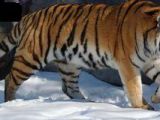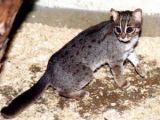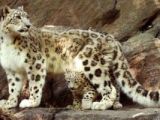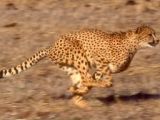Grace, power and intelligence ...This is a combination that fascinated people since ever; in cave painting 30,000 years old found in Europe, scientists discovered images representing the so-called cave lions (direct ancestors of today's lions).
Cats emerged 37 million years ago. First cats were arboreal and resembled the palm civets. They were agile, with a keen hearing and binocular vision.
Modern cats are amazingly homogeneous in their shape, still they vary from the maximum 1.4 kg (3 pounds) and 70 cm (2.5 ft) total length of the rusty spotted cat (Felis rubiginosa) from southern India and Ceylon or 800 grams (1.8 pounds) and 50 cm (1.6 ft) of the black-footed cat (Felis nigripes) to 320 kg (800 pounds) and 3.7 m (12 feet) total length reached by the male Siberian tigers (even captive individuals reached 423 kg or 932 pounds). The smallest cat in the Americas is kodkod (Leopardus guigna) from the Andes of southern Chile, Chiloe Island and nearby Argentina: 2 - 2.5 kg (4.5 - 5.5 Ibs). This cat destroys many small bird nests.
Cats live from tropical jungles and savannas to deserts or cold environments, where temperatures can descend 40oC below zero, on northern forests or mountains over 4,000 m (12,000 ft), missing just in tundras, oceanic islands, Australia (natively) and Antarctica.
Cats have usually elongated bodies, with relatively short, powerful limbs (cheetah is an exception) that enable them to make spectacular jumps. The lion, tiger, panther (leopard) and jaguar can roar, because their hyoid bone and hyoid apparatus is imperfectly ossified; all the other cats (including snow leopard and cheetah) just meow! The loudest roar is produced by the lion. It can be heard 8 km (5 mi) away!
The black panthers are just individuals of the common panther, more common on the southeastern Asia. They carry the spots, only that these are less visible on them.
A tiger can jump up to 10 m (30 ft) and the 50 kg (125 pounds) snow leopard, living in the high mountains of Central Asia), up to 15 m (45 ft) (this is more than a kangaroo)!
Their powerful jaws and throats enable the cats to reach other performances. A tiger can carry over hundreds of meters a 120-170 kg (300-430pounds) wild bore. In Tajikistan (now they are extinct there) tigers were seen crossing rivers while carrying adult dears.
Lions can jump over obstacles carrying preys over 300 kg (750 pounds). Leopards, which rarely overweigh 60 kg (150 pounds) are able to carry up into thorny acacia trees 80 kg (200 pounds) corpses of the impala antelopes they hunt.
They can do this due to their short maxillaries, powerful zygomatic groin (where jaw muscles insert) and the extremely developed canine teeth. Lions and tigers have 7 cm (2.8 in) long canines, but extinct saber-toothed cats had 20 cm (8 in) long canines! Still, the clouded leopard has, proportionately, the longest canine teeth (2 in or 5 cm) of any living feline (imagine the animal is 10 times smaller than a lion or a tiger!).
The saber-toothed cats could have used their huge canines to inflict a deep wound and then wait for the animal to die because of the blood loss and shock; they could not suffocate prey or bite like today's cats. The last extinct saber-toothed cat was Smilodon from North America: it was almost the size of a lion and first Amerindians met it 10,000 years ago.
All cats have retractable claws, except cheetah, and the fore limbs are extremely agile, almost prehensile. Relative to its size, a leopard is considered stronger than a lion. Amongst all felines, the lion is considered the most powerful cat, and specialists consider that in a lion-tiger fight, the lion would be the winner.
Cats have special senses. Their auditory ability surpasses that of the man: they can hear even ultrasounds till 45 kHz (all sound waves over 20 kHz are ultrasounds which cannot be detected by man).
A lion's eye is three times bigger than a human one. The tapetum layer of the retina enables them to see in the slight light of the night and the contraction of their pupil adapts to any amount of light. Their sight is binocular (the visual fields of the eyes interpose, like in humans), enabling them to assess very well distances. These senses, their grace and their varied "camouflage" make them invisible in the environment.
Cats need variable territories, depending on their size.
Male tigers need 3-4,000 square km (1.2-1.5 square mi) while lions move less, necessitating just 250 square km (90 square mi) while the lynxes require just 100-200 hectares when food is plentiful and 20 square km (8 square mi) when food is scarce.
The only sociable cats are lions (which can live in groups up to 6 males, 13 related females and 30 (their) cubs) and male cheetah, which can live in groups up to 3-4. Lion male's mane protects his neck during the fight for territory, while almost only the lighter and faster females hunt. Lions hunt in groups, 1-2 individuals herding the prey to the place where the others stay hidden.
The only other cats seen in groups are females with offspring or mating pairs.
When the male offspring in a lion pride mature, they are chased away, to avoid inbreeding. Another issue: males of the same group co-operate; they never fight for females, maybe just for the most juicy piece of a large prey. Larger and darker male manes are correlated to better nutrition (pigments) and fitness (losers lose a lot of hair in fights), thus females prefer these males.
Cats have a bloody image, the continuously killing machines. But they can last a week between meals and lions sleep at least 18 hours daily! Even the domestic cats sleep 16 hours daily, in episodes, so that they (instinctively) avoid predators.
Instead, when they eat, lions can ingest 40 kg (100 pounds) of food at once... (6-7 kg of meat per day). Only lionesses and male cheetah hunt in groups.
Cats lack stamina, they cannot chase their prey for long time, like wolves or hyenas do. They usually asphyxiate big preys with a bite on the throat; smaller ones are just smashed or bitten on the nape (to touch the brain or crush the neck vertebrae).
Even so, cats are not very effective on hunt: 13 cheetah attacks out of 25 are failed and for lions, success is even smaller.
The cheetah is known for being the fastest land animal; it reaches up to 90 km (65 mi) per hour, but after 300 m is completely exhausted (its respiratory level rises from 16 inspirations/minute to 156).
The most flexible cat is considered margay (Leopardus wiedii) of the tropical forests of the Americas, a species doubling the size of a domestic cat: all limbs can rotate 180o, a fact unique amongst felines. This cat can descend trees head downward like squirrels (only the clouded leopard, too, can do this) or it can hang from the branches using just the rear limbs for grasping or just one limb.
Large cats use to feed laying stretched on the ground, but the snow leopard stays crouched while feeding. It is believed that cheetah's like spotted coat represented the basic model of the cat coat, and circles and stripes evolved from them.
Like other large carnivores, large cats can moisture their legs with urine for cooling down.
Cats are very sensitive to two scents: of garden valerian and musk (including synthetic variants). Ocelots smelling musk lick and scratch themselves for minutes.
Unfortunately, ignorance and greed may lead to the cats' world extinction. Most species are threatened. For instance, the North African lion and 3 tiger subspecies are already history, and the remaining populations are still menaced. Only 25,000 jaguars survive, 5-7,000 snow leopards, and less then 20 leopards in the Sinai peninsula. About 100,000 lions survive in African reserves, but just 12,000 cheetahs Leopards may count up to 500,000 in Africa, but in Asia, populations are much smaller and fragmented.
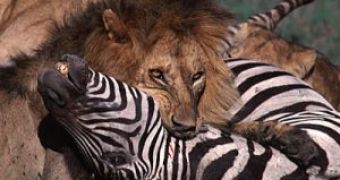
 14 DAY TRIAL //
14 DAY TRIAL // 
